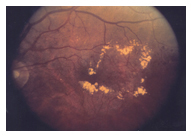Diabetes Dateline
Fall 2008
Older Treatment May Be Better at Preserving Sight for Some Patients with Diabetes
New Drug Treatment Not as Successful, More Side Effects than Laser Treatment
 A new drug therapy for treating abnormal swelling in the eye—a condition called diabetic macular edema—proved less effective than traditional laser treatment in a study funded by the National Eye Institute (NEI), part of the National Institutes of Health. The study, published online in July in the journal Ophthalmology, found that laser therapy is not only more effective than corticosteroids in the long-term treatment of diabetic macular edema, but it also had far fewer side effects. A new drug therapy for treating abnormal swelling in the eye—a condition called diabetic macular edema—proved less effective than traditional laser treatment in a study funded by the National Eye Institute (NEI), part of the National Institutes of Health. The study, published online in July in the journal Ophthalmology, found that laser therapy is not only more effective than corticosteroids in the long-term treatment of diabetic macular edema, but it also had far fewer side effects.
Between 40 and 45 percent of the 18 million Americans diagnosed with diabetes have vision problems such as diabetic macular edema. This condition occurs when the center of the eye’s retina, called the macula, swells, possibly leading to blindness.
Ophthalmologists traditionally use lasers to reduce swelling in these areas. About 5 years ago, early reports of success in treating diabetic macular edema with injections of a corticosteroid called triamcinolone led to the rise in popularity of this alternative treatment. This is the first study to compare the long-term benefits of both treatments and evaluate their potential side effects. While triamcinolone was used in this study, there currently is no scientific rationale that one corticosteroid preparation should be substantially different from another.
“Results of this study should confirm the use of laser treatment for diabetic macular edema and will have a significant impact on quality of life for tens of thousands of people being treated for diabetic macular edema in the United States each year,” said NEI Director Paul A. Sieving, M.D., Ph.D.
A total of 693 participants with diabetic macular edema participated in the study at 88 sites across the United States. Each participant was randomly assigned to corticosteroid or traditional laser treatment. Following treatment, investigators with the Diabetic Retinopathy Clinical Research Network (DRCR.net) tested each participant to determine whether the procedure had prevented substantial vision loss. The DRCR.net is a collaborative network supported by the NEI and dedicated to multicenter clinical research of diabetic retinopathy, diabetic macular edema, and associated conditions. Investigators defined substantial vision loss as reading at least two less lines on a standard eye chart 2 years after entering the study.
In the corticosteroid-treated group, 28 percent experienced substantial vision loss, compared with 19 percent in the laser-treated group. In addition, about 33 percent of the eyes treated with laser therapy showed substantial improvement in vision. Laser treatment had previously been perceived to prevent further vision loss, but not to improve vision.
Increased Eye Pressure
The corticosteroid-treated group was also far more likely to experience side effects. In fact, 51 percent of the corticosteroid-treated group had cataract surgery compared with 13 percent of those in the laser-treated group. In addition, almost half of the corticosteroid-treated group had increased eye pressure, which could lead to glaucoma. One-third of this group needed eye drop medications to lower their eye pressure. The laser-treated group had significantly less of a problem with eye pressure—only 8 percent of the group needed eye drop medications.
Researchers found that, while not as effective as the laser treatment, corticosteroid treatment did provide some benefit. “Our findings raise the possibility that combining laser with corticosteroids might produce greater benefit,” said Neil Bressler, M.D., chair of the DRCR.net and professor of ophthalmology at Johns Hopkins University in Baltimore. The DRCR.net is conducting a study comparing a combination of corticosteroids and laser with laser alone.
For more information about the DRCR.net, visit www.drcr.net. For a fact sheet about diabetic eye disease, go to www.nei.nih.gov/health/diabetic/retinopathy.asp. For a booklet about keeping your eyes healthy when you have diabetes, visit www.diabetes.niddk.nih.gov/dm/pubs/complications_eyes.
[Top]
NIH Publication No. 09–4562
December 2009
|




